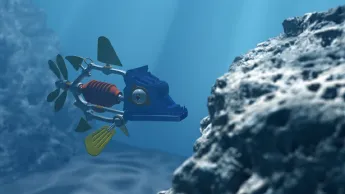Inspired by nature: researchers in robotics can discover a vast amount by investigating living organisms, such as animals and plants. ‘Bio-inspired robotics’ is the term used for the field in which nature serves as the template for optimising technical applications. Dr Robert Siddall, an alumnus of the and senior lecturer in Robotics at the University of Surrey in England, launched a contest for the best ideas in this area in summer 2022. Young people were requested to submit imaginative sketches of robotic animals that promise technical solutions to current challenges. The second round of the commences in April 2023. The contest also indicates the high level of interest in this topic among young people.
Dr Siddall, bio-inspired robotics is seen as an important future technology. What exactly does it involve?
There are various starting points in this area. It generally involves taking a close look at concepts, mechanisms and strategies in nature, and then transferring them to the robotics sector. Aspects of interest are for instance the movement, the behaviour or the sensory system of animals: the way they climb, swim or fly can be imitated and further developed to form resilient engineering innovations. These technical systems can be modelled on creatures like birds, lizards and bears, but even on tiny insects including mosquitoes or flies.
How did you come up with the idea of initiating the Natural Robotics Contest?
The concept is a result of my , which led me to the Max Planck Institute for Intelligent Systems in Stuttgart. As an engineer there, among others I collaborated with zoologists to better understand the complex acrobatics of squirrels and geckos in trees, and to use this knowledge to improve the mobility of robots. I also wanted the contest to introduce a new form of science communication: It’s open to anyone who’s interested in nature and robotics. The principal task is to consider how a bio-inspired robot can help to overcome current challenges. This could conceivably include a mechanical woodpecker, for instance, that inspects trees for diseases, or a robotic falcon that protects sea turtle eggs. The entries clearly evince the issues that people are facing – and the challenges which engineers should urgently address.
To what extent does the contest help generate enthusiasm among young people for developing complex technical innovations?
Participants submitted to us a total of more than 100 applications with sketches in summer 2022. They included numerous teenagers and students from Great Britain and the USA. This remarkable resonance indicates that young people are interested in future technologies. We need to build on this fascination. I believe that bio-robotics is eminently suitable as an entry point into research and technology. Each of us is constantly interacting with nature and most people have an intuitive sense for animal and plant behaviour. The Natural Robotics Contest draws on this intuition and gives everyone the opportunity to present their idea and become creative. We engineers will ultimately implement the most persuasive proposal as a practical prototype, so that the interplay between nature and technology is once again demonstrated.
The winner of the Natural Robotics Contest 2022 is chemistry student Eleanor Mackintosh. What was so persuasive about her proposal for a robotic fish?
This robotic fish uses artificial gill structures to filter out microplastics of a size of two millimetres. Microplastics represent a major issue of our era, since ever more rubbish is entering the oceans – with devastating consequences for marine life. Yet the main task for the robotic fish is not cleaning the water, but rather taking samples: filter systems are not yet capable of differentiating between microplastics and plankton. As illustrated by the robotic fish, however, such technical systems can still assist us in combating microplastics by providing a better understanding of where exactly in the ocean such plastic is located, where it’s drifting, whether it’s sinking to the seabed, and how much pollution is present. We still lack valid data on all of this. The robotic fish provides us with information on water pollution levels. We can analyse the samples it collects in the laboratory.
What other ideas did you obtain in the course of the competition?
We received many imaginative designs: for mechanical dolphins that search for rubbish in the sea and bring it ashore, for birds that track illegal deforestation and slash-and-burn in the rainforest, or for squirrels that plant crops. The submissions also included blood-carrying robotic mosquitoes and artificial bees that help with pollination. The ideas are magnificent and the contest gave me a lot of pleasure. That’s why I’ve decided to relaunch the Natural Robotics Contest in 2023. We’ll start accepting applications from April 2023 onwards.
Read further on the Alumniportal Deutschland
Climate change can only be solved on an interdisciplinary basis. International climate protection scholarship holders at the Alexander von Humboldt Foundation have therefore created a network in which experts from all faculties can exchange ideas about various aspects regarding climate protection. Their podcasts shall raise public awareness of the topic.
An innovative agricultural solution: DAAD alumnus Dr Shaktiman Singh is conducting research into whether ice stupas can resolve the water crisis in the Himalayan desert.

